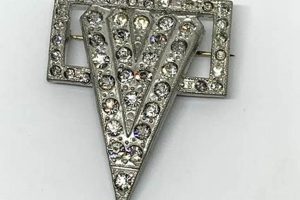Artwork depicting scenes, figures, and themes associated with the American West, created during an earlier period, constitutes a specific genre. This category often encompasses paintings, illustrations, sculptures, and prints that portray cowboys, ranchers, landscapes, and wildlife characteristic of the 19th and early 20th centuries. Examples include Frederic Remington’s bronze sculptures of cowboys on horseback and Charles Marion Russell’s vibrant paintings of frontier life.
The cultural significance of these artistic representations lies in their role in shaping and perpetuating the romanticized image of the American West. These works served to document a rapidly changing era, capturing the spirit of adventure, independence, and resilience associated with the cowboy figure. They provide valuable insight into historical events, societal values, and the environmental landscape of the time, contributing to a deeper understanding of American identity and heritage. Furthermore, these pieces can represent significant financial investments and historical touchstones.
The following sections will explore the specific artistic styles, influential artists, collecting considerations, and preservation techniques relevant to this particular category of Western art. These explorations aim to provide a comprehensive understanding of this enduring artistic legacy.
Guidance on Appreciating Historical Western Depictions
The following offers insights into understanding and engaging with historical Western depictions. These suggestions aim to provide a framework for analyzing, collecting, and preserving this significant art form.
Tip 1: Establish Provenance: Documenting the history of ownership is crucial. Trace the artwork’s origin through bills of sale, exhibition catalogs, and expert authentication. A clear and verifiable provenance enhances value and assures authenticity.
Tip 2: Assess Condition Carefully: Prioritize assessing the artwork’s physical state. Examine for signs of damage, such as tears, fading, or repairs. Professional conservation reports provide essential insights into condition and preservation requirements.
Tip 3: Research the Artists Background: Understanding the artist’s life, influences, and techniques provides valuable context. Consult biographical resources, art historical databases, and scholarly articles to gain a deeper appreciation of the work.
Tip 4: Analyze Composition and Style: Examine the composition, color palette, and brushwork. Identify stylistic influences and artistic movements that may have shaped the artwork’s aesthetic qualities. This analysis offers insight into the artist’s intentions and technical skill.
Tip 5: Consider Subject Matter and Historical Context: Interpret the artwork’s subject matter within its historical context. Research the depicted scenes, figures, and cultural references to understand their significance during the period of creation. This contextual understanding enhances appreciation and informs interpretation.
Tip 6: Seek Expert Appraisal: Obtain professional appraisals from qualified art experts specializing in Western art. Appraisals provide accurate valuations for insurance purposes, estate planning, and potential sales.
Tip 7: Implement Proper Preservation Techniques: Ensure proper storage and display conditions to prevent deterioration. Control humidity, temperature, and light exposure. Consider professional framing and archival materials for protection.
Effective engagement requires a multi-faceted approach, combining historical research, artistic analysis, and careful preservation efforts. By implementing these strategies, individuals can cultivate a deeper understanding and appreciation for these significant pieces.
The subsequent sections will delve into specific case studies and further resources for continued exploration of this artistic genre.
1. Authenticity Identification
The verification of authenticity represents a critical aspect of engaging with historical Western art. Given the genre’s popularity and potential financial value, discerning genuine pieces from reproductions or forgeries is paramount. Effective identification relies on a multi-faceted approach, combining expert analysis, historical research, and scientific examination.
- Signature Analysis
Examining the artist’s signature is a primary step. Signatures evolve over time, and inconsistencies can indicate inauthenticity. Comparing the signature to known examples from authenticated works provides a crucial initial assessment. However, signatures can be forged, so this analysis must be combined with other verification methods. For example, a signature on a purported Charles M. Russell watercolor should be meticulously compared to documented examples from the artist’s known periods.
- Materials and Techniques
Analyzing the materials and techniques used in the artwork offers valuable insights. Pigments, canvas types, and brushstrokes characteristic of a specific period can corroborate or contradict claims of authenticity. For instance, the use of synthetic pigments in a painting purportedly created in the 19th century would immediately raise concerns. Similarly, the application of paint in a style inconsistent with the artist’s known techniques suggests potential inauthenticity. Examination should be conducted by a trained conservator or art historian.
- Provenance Research
Tracing the artwork’s provenance, or history of ownership, is vital. A documented chain of ownership strengthens claims of authenticity, particularly if the piece has been featured in reputable exhibitions or publications. Gaps or inconsistencies in the provenance should be carefully investigated. For example, documentation showing a painting attributed to Frederic Remington in a museum exhibition in the early 20th century provides strong evidence of its authenticity. Conversely, a lack of documented history or a suspicious ownership trail raises red flags.
- Expert Authentication
Consulting with recognized experts in the field of Western art is essential for conclusive authentication. These specialists possess in-depth knowledge of individual artists, their styles, and the historical context of their work. Their expertise allows them to assess the artwork’s overall characteristics and render an informed opinion on its authenticity. Expert authentication often involves a thorough examination of the piece, combined with provenance research and analysis of materials and techniques. Their assessments are invaluable in validating the legitimacy and value of pieces.
The integration of these facets provides a robust framework for authenticity verification. A comprehensive approach minimizes the risk of acquiring fraudulent pieces and ensures that collectors and enthusiasts can confidently engage with genuine examples, preserving and appreciating the genre’s historical and artistic value.
2. Historical Documentation
Historical documentation serves as a crucial pillar supporting the appreciation, authentication, and valuation of artwork depicting the American West from earlier periods. Without corroborating historical evidence, the artistic representations risk becoming detached from their context, potentially diminishing their cultural significance and financial worth. The presence of detailed records regarding the artwork’s creation, provenance, and exhibition history directly impacts its perceived authenticity and position within the broader art historical narrative. A meticulously maintained historical record establishes a direct connection to the era and subject matter depicted, enhancing its appeal to collectors and institutions.
The effect of comprehensive historical documentation on a works value is demonstrably significant. For example, paintings by Charles M. Russell or Frederic Remington that have been extensively documented through exhibition catalogs, letters, and period photographs command higher prices in the art market. This is because such documentation provides verifiable evidence of their origin, historical context, and cultural impact. Conversely, works lacking clear provenance or historical validation are often viewed with skepticism, leading to lower appraisals and difficulty in establishing their true value. Detailed historical context is particularly important in this genre because authenticity can be difficult to ascertain without it.
In conclusion, the symbiotic relationship between historical documentation and artwork of the early American West cannot be overstated. Thorough documentation functions as a vital component, adding layers of meaning, confirming authenticity, and driving market valuation. The challenge lies in consistently preserving and accessing these records, ensuring that these artworks continue to be understood and appreciated within their appropriate historical frameworks. A commitment to diligent historical research is essential for both art historians and collectors.
3. Artistic Style
The representation of the American West in vintage art is intrinsically linked to the artistic styles prevalent during the late 19th and early 20th centuries. These styles shaped not only the aesthetic qualities of the artworks but also the way the West was perceived and understood. The influence of Realism, for example, led artists like Frederic Remington to depict scenes of cowboy life and military encounters with a focus on accuracy and detail, aiming to provide viewers with an unvarnished glimpse into the realities of the frontier. In contrast, the romanticized visions presented by artists such as Charles Marion Russell, while still grounded in observation, incorporated elements of idealized heroism and nostalgia, reflecting a desire to capture the spirit of a vanishing era.
The choices artists made regarding composition, color palette, and brushwork directly influenced the narrative and emotional impact of their works. For instance, the dramatic lighting and dynamic compositions found in many Western paintings heightened the sense of adventure and danger associated with frontier life. The use of warm, earthy tones evoked the vast landscapes and rugged terrain of the West, while the depiction of figures in action conveyed the energy and resilience of its inhabitants. Understanding these stylistic choices is crucial for interpreting the artist’s intent and the cultural values they were communicating. The loose brushwork and emphasis on light effects in landscapes by Thomas Moran, while not strictly “cowboy art,” shaped the perception of the Western landscape that served as a backdrop for cowboy narratives.
Appreciating the connection between artistic style and vintage cowboy art is essential for informed collecting, preservation, and art historical analysis. Recognizing the stylistic characteristics of different artists and movements allows collectors to identify authentic works and assess their value accurately. Conservators can use this knowledge to implement appropriate preservation techniques that respect the original artistic intent. Art historians rely on stylistic analysis to contextualize Western art within the broader history of American art and culture. The understanding of style ensures that these artistic representations are not merely viewed as depictions of cowboys and landscapes, but as complex cultural artifacts reflecting a specific moment in American history.
4. Subject Matter
Subject matter forms the core identity of vintage cowboy art. The depiction of cowboys, cattle drives, frontier landscapes, and conflicts with Native American tribes are not merely aesthetic choices; they define the genre. The selection of these subjects creates a visual narrative reflecting the historical realities and romanticized ideals of the American West during a specific period. The cause-and-effect relationship is evident: the historical events and cultural phenomena of the late 19th and early 20th centuries prompted artists to document and interpret these subjects through their respective artistic lenses. The importance of subject matter lies in its ability to convey specific historical information, social values, and cultural perspectives associated with the cowboy era.
Examples include Frederic Remington’s focus on depicting the U.S. Cavalry’s interactions with Native American tribes, reflecting a dominant historical narrative of the time, and Charles Marion Russell’s romanticized portrayals of cowboys as independent figures, embodying the spirit of the frontier. The practical significance of understanding subject matter is evident in art authentication and historical interpretation. The accuracy of depicted details, such as clothing, equipment, and landscape features, can serve as indicators of authenticity and provide valuable insights into the artist’s historical awareness and intention. Analyzing the subject matter reveals biases, perspectives, and ideological positions of the artists and the culture that produced these works.
In conclusion, the subject matter constitutes the defining characteristic of vintage cowboy art. It provides crucial insight into historical events and cultural values while offering a framework for authentication and interpretation. Challenges arise when analyzing depictions of marginalized groups, demanding critical perspectives that acknowledge historical power dynamics and biases. By understanding the subject matter, viewers engage with these artworks not only as aesthetic objects but as historical documents offering nuanced perspectives on a transformative period in American history.
5. Condition Assessment
The evaluation of physical state represents a crucial aspect of engaging with historical Western art. The deterioration of materials, the presence of damage, and the extent of previous restoration efforts all impact the aesthetic value, historical significance, and market price of these pieces. A thorough assessment is therefore essential for informed acquisition, preservation, and art historical analysis.
- Paint Layer Integrity
The stability and adherence of the paint layer are primary concerns. Cracking, flaking, and paint loss can significantly detract from the visual impact and threaten the long-term preservation of the artwork. Examining the paint surface under magnification reveals the extent of these issues. Previous restoration attempts can sometimes exacerbate these problems if incompatible materials were used. For example, the presence of extensive craquelure (a network of fine cracks) may indicate age and natural aging of the paint film, while large areas of paint loss require professional conservation to prevent further degradation.
- Canvas or Support Structure
The canvas or panel supporting the paint layer must be structurally sound. Tears, punctures, and warping can compromise the stability of the artwork and lead to further damage. Examination of the reverse of the canvas is essential to identify repairs, relining, or other structural modifications. An uneven or sagging canvas indicates potential problems requiring professional attention. In the case of works on paper, the condition of the paper itself, including acidity, foxing (brown spots), and tears, must be evaluated.
- Varnish and Surface Coatings
Varnishes and other surface coatings are often applied to protect the paint layer, but they can degrade over time, causing discoloration, yellowing, or clouding. These changes can obscure the original colors and details of the artwork. Examination under ultraviolet light can reveal the presence of old varnish layers and previous cleaning or restoration attempts. Improper cleaning can damage the paint surface, highlighting the importance of professional assessment and treatment.
- Environmental Damage
Exposure to environmental factors such as light, humidity, and temperature fluctuations can cause significant damage to artwork. Light can fade pigments, humidity can promote mold growth, and temperature changes can cause expansion and contraction, leading to cracking and other forms of deterioration. Assessing the artwork’s history of environmental exposure is important for understanding its current condition and developing appropriate preservation strategies. Pieces displayed in uncontrolled environments may exhibit greater levels of damage compared to those kept in stable, climate-controlled conditions.
Integrating these facets into a comprehensive evaluation provides a detailed understanding of an artworks health. This assessment informs conservation decisions, influences valuation, and supports informed collecting practices. The long-term preservation of these culturally significant works relies on diligent assessment and appropriate care.
6. Provenance Tracing
Establishing a comprehensive ownership history represents a critical component in the valuation and authentication of vintage cowboy art. The ability to trace an artwork’s lineage back to its origin provides essential validation of its authenticity, historical significance, and market value. A clear and unbroken chain of ownership demonstrates a traceable connection to the artist, subject matter, and historical context, mitigating the risk of acquiring forgeries or misattributed pieces.
- Establishing Authenticity and Verifying Attribution
Provenance tracing serves as a foundational method for confirming the authenticity of vintage cowboy art pieces attributed to renowned artists like Frederic Remington or Charles M. Russell. A documented history of ownership, verifiable through bills of sale, exhibition catalogs, and estate records, strengthens claims of authorship and validates the artwork’s origin. The absence of a clear provenance raises immediate concerns regarding potential forgeries or misattributions, necessitating further investigation and expert analysis. For example, a painting purportedly by Russell should be accompanied by records that trace its ownership back to the artist’s estate or documented sales shortly after his lifetime.
- Determining Historical Context and Cultural Significance
The history of ownership can illuminate the historical context and cultural significance of vintage cowboy art. Tracing the artwork’s past through various collections, exhibitions, and historical events reveals its reception and influence on cultural narratives. For instance, a painting that has been part of significant Western art exhibitions or owned by notable figures in Western history acquires added cultural value and prestige. This historical context informs art historical interpretations and enhances the overall appreciation of the artwork’s role in shaping perceptions of the American West. Documentation of its appearance in early 20th-century publications or exhibitions is particularly valuable.
- Assessing Market Value and Investment Potential
Provenance significantly affects the market value and investment potential of vintage cowboy art. A well-documented provenance that includes notable collectors or institutions enhances the artwork’s desirability among buyers and collectors, increasing its potential resale value. Artwork with a proven history of increasing value commands higher prices at auction or private sales. Conversely, gaps or uncertainties in the provenance can negatively impact the valuation, making it difficult to establish a fair market price. High-profile pieces with impeccable provenance are often considered blue-chip investments within the Western art market.
- Mitigating Legal and Ethical Risks
Thorough provenance tracing helps mitigate legal and ethical risks associated with acquiring vintage cowboy art. A clear chain of ownership ensures that the artwork has not been stolen, illegally exported, or subject to other legal disputes. Verifying that the artwork has been legally acquired and transferred throughout its history protects buyers from potential legal liabilities and ethical concerns. Provenance research also helps identify potential claims from previous owners or their heirs, ensuring a clean title and legitimate transfer of ownership. Due diligence in provenance tracing is essential for ethical collecting practices and legal compliance.
In summary, provenance tracing represents an essential element in the study, authentication, and market evaluation of vintage cowboy art. A meticulously researched and documented provenance provides critical validation, enhances cultural understanding, and reduces the risks associated with acquisition. By prioritizing the establishment of a clear ownership history, collectors, institutions, and art historians contribute to the responsible preservation and appreciation of this significant aspect of American artistic heritage. Such commitment ensures the lasting legacy of cowboy art within the art market and within the cultural narrative of the American West.
7. Market Valuation
The economic assessment of depictions from the Old West is intrinsically linked to several factors. Scarcity, artist reputation, provenance, condition, and subject matter all contribute to determining the monetary worth of these pieces. High demand coupled with a limited supply of works by renowned artists, such as Frederic Remington and Charles Marion Russell, often results in elevated prices. Provenance establishes authenticity and can significantly impact the value, particularly if the piece was previously owned by a notable collector or featured in a prestigious exhibition. Condition is a crucial determinant; well-preserved artworks command higher prices compared to those exhibiting damage or extensive restoration. Subject matter also plays a role, with depictions of iconic Western scenes generally attracting greater interest and, consequently, higher market values.
Real-world examples illustrate the practical significance of market valuation within this genre. At auction, Remington’s bronze sculptures of cowboys on horseback have consistently sold for millions of dollars, reflecting the artist’s established reputation and the scarcity of his three-dimensional works. Paintings by Russell, depicting scenes of cowboy life and encounters with Native American tribes, also fetch substantial prices, driven by the romanticized view of the West and the artist’s skill in capturing these narratives. The practical application of understanding market valuation extends to insurance appraisals, estate planning, and investment strategies. Accurate valuation is essential for protecting and managing artwork assets. Furthermore, informed collectors and investors use market data to make strategic decisions, identifying undervalued pieces or recognizing emerging trends within the Western art market.
In summary, the market valuation of artwork from the American West is a complex interplay of artistic, historical, and economic factors. This economic assessment offers critical insight into the cultural value and significance of these artistic representations. Challenges arise from fluctuating market trends, subjective aesthetic preferences, and the difficulty of definitively authenticating certain pieces. The relationship between market valuation and this genre emphasizes the importance of expertise, research, and careful consideration when acquiring, preserving, or selling these culturally significant artifacts. By understanding this intricate dynamic, collectors and institutions contribute to the responsible stewardship of this artistic legacy.
Frequently Asked Questions
The following addresses common queries regarding historical artistic renderings of the American West. The information is intended to provide clarity and assist in understanding this specific art form.
Question 1: What distinguishes representations of the American West from other genres of art?
The primary distinction lies in its subject matter. This art form focuses on depictions of cowboys, landscapes, and historical events specific to the American West during the 19th and early 20th centuries. Style can vary considerably.
Question 2: How does one assess the authenticity of older Western paintings?
Authenticity verification involves a multi-faceted approach. This includes expert appraisal, provenance research, analysis of materials and techniques, and examination of the artist’s signature. No single factor definitively confirms authenticity.
Question 3: What factors contribute to the value of these artistic pieces?
Value is determined by several elements, including artist reputation, condition, provenance, subject matter, and market demand. Pieces by renowned artists with well-documented histories generally command higher prices.
Question 4: What are common preservation challenges associated with these depictions?
Common challenges include preventing paint layer deterioration, canvas damage, varnish yellowing, and environmental degradation. Proper storage and display conditions, along with professional conservation, are crucial for preservation.
Question 5: How does the historical context influence the interpretation of vintage cowboy art?
Historical context provides essential insights into the social, cultural, and political landscape in which the artwork was created. Understanding this context enriches appreciation and informs interpretation of the artist’s intent.
Question 6: What are some reputable resources for learning more about historical artistic renderings of the West?
Reputable resources include museum collections, art historical databases, scholarly publications, and expert appraisals from qualified art professionals specializing in Western art.
In summary, understanding the nuances of subject matter, authenticity, valuation, preservation, and historical context is essential for informed engagement with this art form.
The following sections will explore specific case studies and additional resources for continued investigation into this significant artistic legacy.
Conclusion
The preceding exploration has illuminated several key facets pertaining to vintage cowboy art. This encompasses an understanding of artistic styles, authentication processes, the significance of historical documentation, and factors influencing market valuation. Furthermore, the importance of proper preservation techniques has been underscored, emphasizing the need for careful stewardship of these cultural artifacts. These elements are all related to the keyword of the article.
Continued scholarly inquiry and responsible collecting practices are essential to ensure that this artistic legacy endures. It is imperative that institutions and individuals alike prioritize the preservation and study of vintage cowboy art, thereby fostering a deeper appreciation for the historical narratives and artistic achievements encapsulated within these works.







